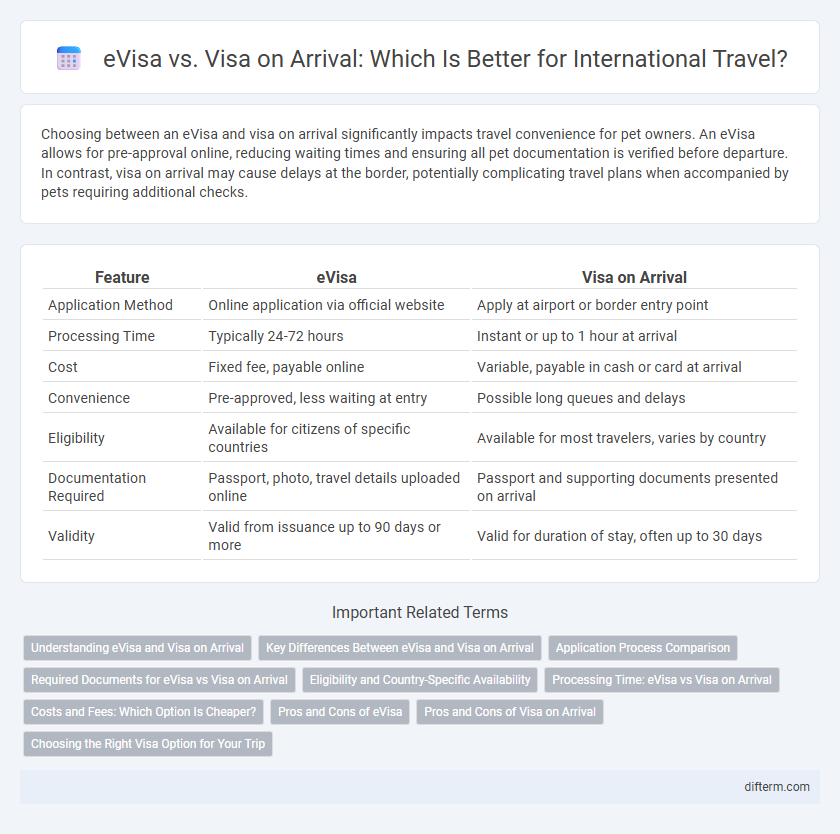Choosing between an eVisa and visa on arrival significantly impacts travel convenience for pet owners. An eVisa allows for pre-approval online, reducing waiting times and ensuring all pet documentation is verified before departure. In contrast, visa on arrival may cause delays at the border, potentially complicating travel plans when accompanied by pets requiring additional checks.
Table of Comparison
| Feature | eVisa | Visa on Arrival |
|---|---|---|
| Application Method | Online application via official website | Apply at airport or border entry point |
| Processing Time | Typically 24-72 hours | Instant or up to 1 hour at arrival |
| Cost | Fixed fee, payable online | Variable, payable in cash or card at arrival |
| Convenience | Pre-approved, less waiting at entry | Possible long queues and delays |
| Eligibility | Available for citizens of specific countries | Available for most travelers, varies by country |
| Documentation Required | Passport, photo, travel details uploaded online | Passport and supporting documents presented on arrival |
| Validity | Valid from issuance up to 90 days or more | Valid for duration of stay, often up to 30 days |
Understanding eVisa and Visa on Arrival
An eVisa is an electronic travel authorization obtained online before departure, allowing travelers to bypass embassy visits and streamline entry procedures. In contrast, a Visa on Arrival is issued at the point of entry, often requiring longer wait times and potential paperwork upon arrival. Knowing the differences helps travelers choose the most convenient and efficient option based on destination country regulations and personal itinerary.
Key Differences Between eVisa and Visa on Arrival
eVisa requires travelers to apply and obtain approval online before departure, providing a seamless entry process and reducing wait times at the border. Visa on Arrival is granted upon arrival at the destination country, often involving longer queues and variable approval criteria, which may lead to uncertainties. Key differences include application timing, processing speed, and convenience, influencing travelers' choices based on their itinerary and travel preferences.
Application Process Comparison
The eVisa application process is completed online before travel, allowing applicants to submit required documents and receive approval electronically, often within a few days. Visa on arrival requires travelers to apply and pay upon entering the destination country, which can involve lengthy queues and documentation checks at the border. Choosing eVisa reduces wait times and streamlines entry, ensuring smoother travel planning and faster immigration clearance.
Required Documents for eVisa vs Visa on Arrival
Applying for an eVisa typically requires submitting a scanned passport, recent passport-sized photo, and sometimes a travel itinerary or proof of accommodation, all completed online before departure. In contrast, visa on arrival often demands the original passport, a printed passport-sized photo, proof of return or onward travel, and payment in local currency upon entry. Travelers benefit from preparing specific documents in advance for each visa type to ensure smooth processing and avoid entry delays.
Eligibility and Country-Specific Availability
eVisa eligibility depends on the applicant's nationality and the specific country's eVisa program, with most countries offering eVisas to travelers from designated nations, often requiring online application before departure. Visa on arrival availability varies by country and is generally limited to travelers from countries with bilateral agreements or specific tourism policies, allowing entry without prior application but often involving eligibility checks upon arrival. Countries like India, Kenya, and Thailand provide both options but differ in eligibility criteria and application processes, making it essential to verify the correct visa category based on your nationality and destination country's rules.
Processing Time: eVisa vs Visa on Arrival
eVisa processing time typically ranges from 24 to 72 hours, allowing travelers to obtain approval before departure, ensuring a smoother entry experience. Visa on arrival often involves longer waiting periods at the airport due to on-site application and approval processes, which can vary from 30 minutes to several hours depending on the destination and infrastructure. Pre-arranged eVisas reduce uncertainty and streamline border control procedures compared to the sporadic delays commonly faced with visa on arrival.
Costs and Fees: Which Option Is Cheaper?
eVisa applications typically involve a fixed processing fee paid online before travel, often making costs more predictable and sometimes cheaper than visa on arrival fees, which can vary by airport and include additional service charges. Visa on arrival fees may include extra charges for expedited processing or currency exchange, potentially increasing overall expenses. Travelers seeking cost-effective options should compare official government eVisa fees with on-arrival visa prices specific to their destination country.
Pros and Cons of eVisa
eVisa offers travelers the convenience of applying online before departure, reducing wait times at immigration and providing greater certainty of entry approval compared to visa on arrival. However, eVisa applications sometimes require advance planning and internet access, which can be a drawback in urgent travel situations. While eVisa streamlines border control processes, travelers must ensure application accuracy to avoid delays or rejections, a risk less prominent with visa on arrival options.
Pros and Cons of Visa on Arrival
Visa on Arrival (VoA) offers travelers convenience by allowing them to obtain entry permits directly at the destination airport, reducing the need for pre-trip visa applications and paperwork. However, VoA can lead to unpredictable wait times, potential higher fees, and the risk of visa denial upon arrival, which may disrupt travel plans. It is less suitable for travelers seeking guaranteed entry or those visiting countries with strict immigration policies requiring advance authorization.
Choosing the Right Visa Option for Your Trip
Selecting the appropriate visa option depends on factors such as destination country policies, processing time, and travel convenience. eVisa offers pre-approval online, reducing wait times and providing more control before departure. Visa on arrival suits travelers seeking flexibility but may involve longer queues and uncertainty upon arrival.
eVisa vs visa on arrival Infographic

 difterm.com
difterm.com